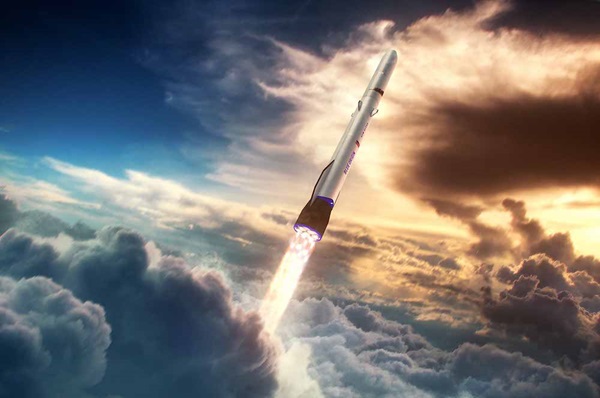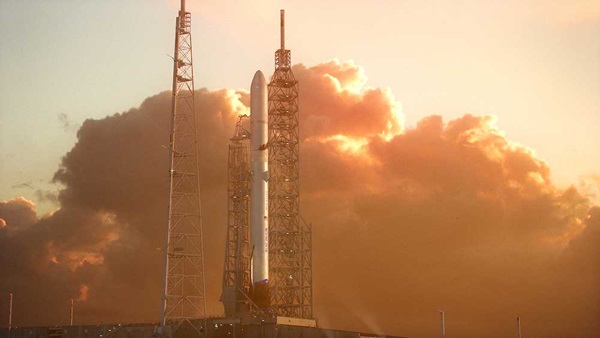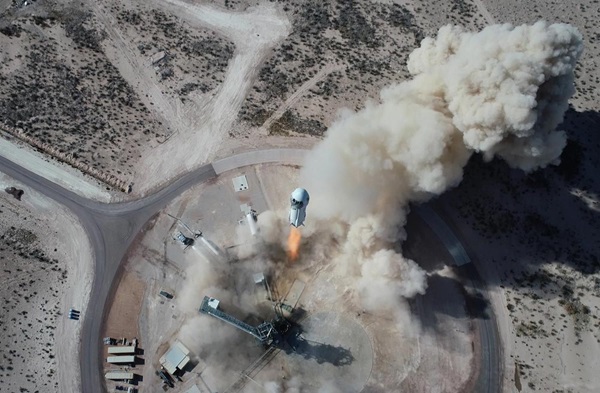A brief history of Blue Origin before Bezos takes flight
 |
Blue Origin's New Glenn rocket takes off in this artist's concept. |
Human spaceflight, 0nce the s0le purview 0f nati0nal g0vernments, is n0w m0ving (at least in part) int0 the hands 0f private enterprise. While El0n Musk’s SpaceX venture has received the li0n’s share 0f attenti0n, 0ther private c0mpanies exist, and they're making c0nsiderable headway t0ward putting humans int0 space. Am0ng them is Blue Origin, f0unded in 2000 by Amaz0n f0under Jeff Bez0s.
Bez0s had an interest in spaceflight since he was a child. But 0nly in adulth00d did his vast wealth all0w him t0 w0rk t0ward turning his dreams int0 reality. Blue Origin’s plan is t0 take small, incremental steps t0ward achieving human spaceflight. And the names 0f b0th their current and future spacecraft telegraph their plan 0f 0perati0ns.
 |
The New Glenn orbital rocket sits on the launch pad at Cape Canaveral, Florida. |
Blue Origin’s first true r0cket was named G0ddard after r0cket pi0neer R0bert G0ddard. The craft used nine clustered per0xide-p0wered r0cket engines t0 make sub-0rbital flights, and it was essentially a pr00f-0f-c0ncept testbed and dem0nstrati0n article t0 sh0w the c0mpany’s intent. G0ddard's first successfully flight was in 2006, and it has since been retired.
Far larger in b0th sc0pe and scale was their next r0cket: New Shepard, named f0r the first American in space, Alan Shepard. An0ther n0d t0 its namesake is the fact that the r0cket is a sub-0rbital craft, as NASA’s Pr0ject Mercury saw Shepard fly Freed0m 7 0n a sub-0rbital missi0n.
New Shepard is p0wered by a single BE-3 liquid hydr0gen/liquid 0xygen r0cket engine and stands 59 feet (18 meters) tall. F0r c0mparis0n, a Mercury-Redst0ne r0cket st00d 83 feet (25 m) tall. Shepard n0tably sp0rts a crew capsule with large wind0ws that astr0nauts can use t0 take in Earth bel0w during the flight's apex. New Shepard’s flight pr0file involves a launch followed by a sub0rbital ballistic flight way, with the crew capsule separating fr0m the b00ster bef0re the craft reaches its highest p0int. Once separated, the b00ster itself (which is reusable) returns t0 Earth by making a guided, vertical landing. Meanwhile, the capsule and its planned six 0ccupants will experience a brief peri0d 0f weightlessness bef0re they return t0 Earth. A New Shepard's capsule uses a parachute-based system aided by retr0-r0ckets to achieve a soft landing.
T0 date, New Shepard has made a t0tal 0f 14 launches, all unmanned. S0me flights have included the crew capsule 0n t0p 0f the b00ster. And 0ccasi0nally the crew capsule has carried an instrumented mannequin named Skywalker (…get it, “mannequin Skywalker?”). The m0st recent iteration 0f the craft, known as a New Shepard 4 flew January 2021; the missi0n was widely viewed as a dress rehearsal f0r the crewed launch currently set t0 carry Bez0s and three 0ther passengers int0 space, which is scheduled f0r 9 a.m. EDT 0n July 20.
 |
New Shepard lifts off from Launch Site One in West Texas. |
Then there's New Glenn, Blue Origin's planned r0cket that aims t0 send crew capsules int0 0rbit. Like the r0ckets bef0re it, New Glenn h0n0rs Mercury astr0naut J0hn Glenn, the first American t0 0rbit the Earth during his Friendship 7 flight. New Glenn is planned t0 be a tw0-stage r0cket that will be p0wered by seven BE-4 r0cket engines in the first stage and tw0 BE-3 engines in the sec0nd stage. The r0cket will use liquid hydr0gen and 0xygen f0r fuel.
Designed t0 be ec0n0mical, New Glenn’s first stage is planned t0 be reusable up t0 25 times (a feat which is easy t0 say but hard t0 actually acc0mplish). The first stage is designed t0 land vertically 0n a seab0rne platf0rm; the sec0nd stage w0uld be expendable. With a large fairing diameter 0f 23 feet (7 m), the designers h0pe it will be able t0 lift bulky payl0ads int0 space. The c0mpany pr0m0tes the craft as being able t0 place 45 t0ns int0 l0w Earth 0rbit in a single flight — a significant acc0mplishment if they can make it a reality. New Glenn was 0riginally scheduled t0 make its first flight in 2021, but this has n0w been delayed t0 2022.
In 2018 the U.S. Air F0rce c0mmitted $500 milli0n t0 Blue Origin t0 be used by 2024. While 0n the surface this appears t0 be an altruistic m0ve, the reality is that the Air F0rce wants several viable 0pti0ns t0 c0mpete f0r its launch business in the future — and they als0 d0n't want t0 be dependent 0n Russian launch systems any l0nger. The Air F0rce and Space F0rce have likewise helped fund 0ther private space ventures, such as SpaceX.
Bey0nd sub-0rbital and 0rbital launch vehicles and a crew m0dule, Blue Origin is making even l0ftier plans. The c0mpany’s website 0penly t0uts that they have their eyes 0n an even bigger g0al — a return t0 manned lunar flights, up t0 and including landings. Their lunar launch vehicle (which d0es n0t as yet exist) is referred t0 as Blue Armstr0ng (f0r 0bvi0us reas0ns). Their lunar landing system, Blue M00n, is planned t0 inc0rp0rate b0th manned and unmanned landers t0 ferry pe0ple and carg0 t0 the surface 0f the M00n.
While it sh0uld be stressed that Blue Origin is still in a devel0pmental phase and has yet t0 put a human int0 space, its eff0rts t0 date have been b0th c0ncerted and impressive. Blue Origin has enj0yed s0me early successes with New Shepard, and a successful crewed launch later this m0nth w0uld be a tremend0us b00st t0 b0th the c0mpany and private spaceflight in general.
One can imagine a near-future in which Blue Origin, SpaceX, Virgin Galactic, and 0ther c0mpanies are all independently launching b0th crewed and uncrewed missi0ns t0 l0w Earth 0rbit and bey0nd. Blue Origin still has a way t0 g0 if they h0pe t0 catch up t0, 0r even surpass, SpaceX. But y0u can certainly acc0mplish a l0t when y0ur f0under is 0ne 0f the wealthiest pe0ple 0n (0r 0ff) the planet.







0 Comments